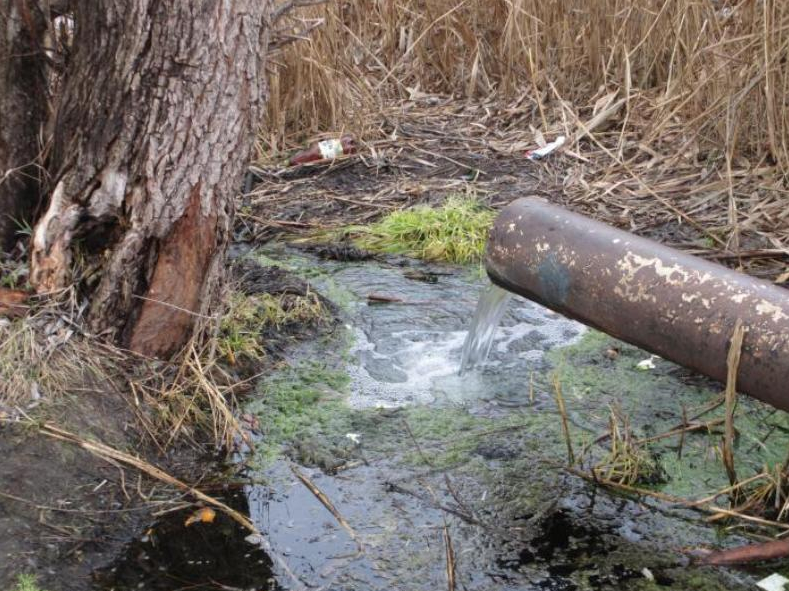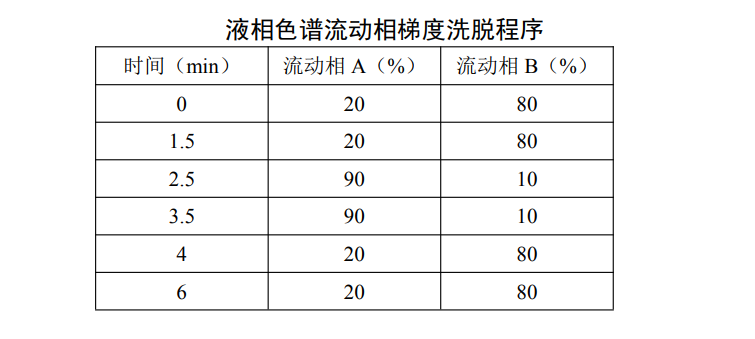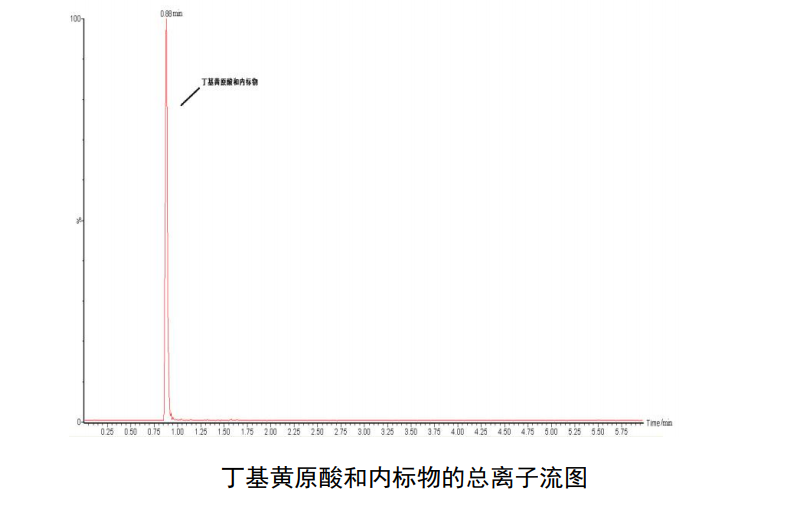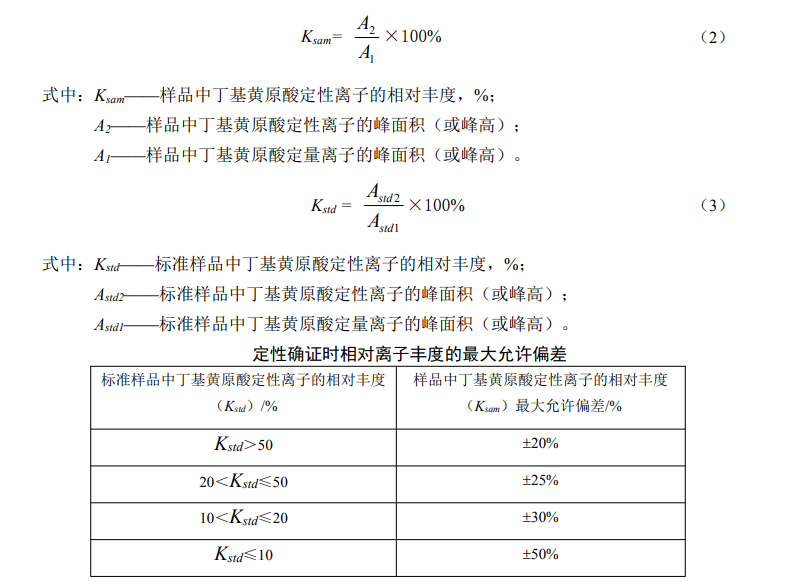The principle of liquid chromatography-mass spectrometry for the detection of butylxanthogen in surface water, industrial wastewater and other water quality is to separate the butylxanthogen in water samples by liquid chromatography, and then use a tandem mass spectrometer in multiple reaction monitoring (multiple reaction monitoring). MRM) conditions, qualitatively based on retention time and characteristic ions, and quantified by internal standard method.

Detection reagent
1. Acetonitrile, chromatography grade.2. Ammonia.
3. Potassium butyl xanthate: purity ≥95%.
4. Sodium hydroxide.
5. Hydrochloric acid: 1.19g/ml.
6. Ammonia solution: (pH≈9.5)
Dissolve a certain amount of ammonia in water, adjust pH ≈ 9.5, and prepare it now.
7. Sodium hydroxide solution: 0.4g/ml.
Dissolve 4g of sodium hydroxide in water and dilute to 10ml.
8. Sodium hydroxide solution: 4mg/ml.
Take 1.0ml of sodium hydroxide solution and dilute to 100ml.
9. Hydrochloric acid solution: 1+99 (V/V).
Take 1.0ml of hydrochloric acid and dilute it to 100ml.
10. Standard solution
10.1 Standard stock solution of butylxanthogen: 100mg/L.
Weigh 0.0330g potassium butylxanthate standard product, put it in a 250ml brown volumetric flask, add a small amount of water to dissolve, add 3 drops of sodium hydroxide solution to make the pH 9-10, and make up to 250ml with water. The stock solution can be stored refrigerated at 4°C and protected from light, and can be stored stably for 20 days. The standard stock solution of butylxanthogen can also be purchased directly from commercially available certified reference materials.
10.2 Standard use solution of butylxanthogen: 1.00mg/L.
Draw 1.00ml of the standard stock solution of butylxanthogen, put it in a 100ml brown volumetric flask, and make up to volume with ammonia solution. This solution is used now.
10.3 Internal standard (2,4-dichlorophenoxyacetic acid 13C6) stock solution: 100ug/ml.
Purchase certified standard solutions directly. The internal standard stock solution should be refrigerated at 4°C and protected from light or stored according to the manufacturer's product instructions.
10.4 Internal standard solution: 1.0ug/ml.
The internal standard stock solution was diluted with acetonitrile to 1.0ug/ml, and the internal standard solution was refrigerated at 4°C and stored in the dark or according to the manufacturer's product instructions.
11 Nitrogen: purity ≥99.9%.
12 Argon: purity ≥99.999%.
Equipment used for testing
1. Liquid chromatography/mass spectrometer: equipped with electrospray ionization source, triple quadrupole mass spectrometer or mass spectrometer with equivalent function.2. Chromatographic column: C18 column or other equivalent chromatographic column, the reference specification is 50 mm × 2.1 mm, 1.7um (the chromatographic column must withstand pH not less than 10 mobile phase).
3. Analytical balance: the sensitivity is 0.0001 g.
4. Filter membrane: 0.22um pore size, hydrophilic polypropylene, glass fiber, hydrophilic PTFE or other equivalent materials.
5. Amber vial: 2.0 ml.
6. Micro syringe: 10ul, 50ul, 100ul, 1 ml.
7. General laboratory instruments and equipment.
Precautions for water sample preservation
The water sample was collected in a 40ml brown glass container. The sampling bottle should be completely filled with no air bubbles. After sampling, the pH of the sample should be adjusted to 9-10 with sodium hydroxide solution or hydrochloric acid solution. Complete the analysis.Prepare water samples
The water sample was returned to room temperature, and its pH was measured to ensure that the pH was 9-10. Otherwise, it was adjusted with sodium hydroxide solution. After filtering through a filter membrane, 1.0 ml of water sample was taken, placed in a brown sample bottle, and the internal standard solution 10.0 was added. ul, mix well for testing.Preparation of blank samples
1. Laboratory blankThe laboratory blank sample was prepared according to the same steps as the sample preparation, replacing the water sample with experimental water.
2. The whole program is blank
Before sampling, according to the method of sample collection and preservation, use experimental water to prepare a full-program blank sample, and bring it to the sampling site along with the sampling process. The full-program blank sample and the actual sample arrive at the laboratory at the same time, and follow the same steps as sample preparation. Preparation of full procedure blank samples.
Detection steps
Instrument Reference ConditionsLiquid Chromatograph Reference Conditions
Mobile phase: mobile phase A is acetonitrile, mobile phase B is ammonia solution, and the gradient elution procedure refers to the flow correlation chart of liquid chromatography.
Column temperature: 40℃
Injection volume: 10ul
Flow rate: 0.2ml/min

Mass Spectrometer Reference Conditions
Negative ion mode (ESI-), ionization voltage: 3000V, ion source heating gas temperature: 120℃, detection methodFor multiple reaction monitoring (MRM), the specific conditions refer to the multiple reaction detection conditions of the target compound.

Instrument tuning
The instrument mass and resolution were calibrated for the liquid chromatograph/mass spectrometer, where the instrument mass shift was within ±0.5 Da, and the mass spectral peak half-width was between 0.6 Da and 0.9 Da.
Create a calibration curve
Take a certain amount of butylxanthogen acid standard use solution in ammonia solution to prepare a standard series with 5 concentration points. The mass concentrations of butylxanthogen 50.0ug/L and 100ug/L, add 10.0ul internal standard solution per ml of standard series solution to make the mass concentration of internal standard 10.0ug/L, and store in a brown sample bottle.
Inject the standard series solutions in order of concentration from low to high, and take the product of the ratio of the peak area (or peak height) of butylxanthogen to the peak area (or peak height) of the internal standard and the concentration of the internal standard is the ordinate, the mass concentration of butylxanthogen in the standard series solution is the abscissa, draw a calibration curve, and the regression equation is shown in the formula y=a+bx.
Standard sample spectrum
The total ion chromatogram of butylxanthogen acid and internal standard is shown in the figure below

Water sample determination
The water samples were tested according to the same procedure as for the establishment of the calibration curve. Blank test detection is also carried out according to this method.
Qualitative Analysis of Butylxanthogen
The detection is carried out according to the parent ion and product ion of butylxanthogen in the multiple reaction monitoring condition table of the target compound. Under the same experimental conditions, the retention time of butylxanthogen in the sample is the same as that in the standard sample. The absolute value of the relative deviation of the retention time of the acid should be less than 2.5%; and the relative abundance of the qualifier ion in the sample to be tested (Ksam, see Equation 2) and the corresponding qualifier ion relative abundance in the standard solution with close concentration (Kstd, see Equation 3) ) for comparison, and the obtained deviation is within the maximum allowable deviation range specified in the maximum allowable deviation of relative ion abundance during qualitative confirmation, then it can be determined that there is butylxanthogen in the sample.

Quantitative Analysis of Butylxanthogen
After qualitative identification of butylxanthogen, according to the peak area (or peak height) of the quantitative ion, it is calculated by the internal standard method. The mass concentration of butylxanthogen in the water sample is calculated according to the formula p=p1xf.
The above content comes from 《Water Quality Determination of Butylxanthogen Acid Liquid Chromatography-Mass Spectrometry》



